
The real lowdown on markdowns:
current practices and smart solutions
About this whitepaper
In this whitepaper, we explore the increasing challenge of managing perishable inventory, and how retailers can leverage cognitive technology to help reduce food wastage.
You’ll discover:
- Why food wastage is high on the agenda
- The constant challenge of supply chain forecasting
- Differing approaches to markdown
- The benefits of a dynamic markdown strategy
Download as a PDF
Download whitepaper
Introduction
Managing perishable inventory is a huge challenge for supermarkets and grocers as customers demand the freshest food and the widest choice, in abundance. This customer expectation is coupled with the increasing role that Environmental, Social and Governance (ESG) initiatives are playing in how retailers must operate. As a result, food waste is now a consistent theme that all retailers are now working to manage and reduce.
There are a host of different mitigants to the food waste challenge that retailers can leverage, from surplus food charity redistribution to energy conversion. However, any mitigation efforts, per the WRAP food waste hierarchy (Figure 11), should first begin with preventative approaches, before these recovery and disposal channels are explored.
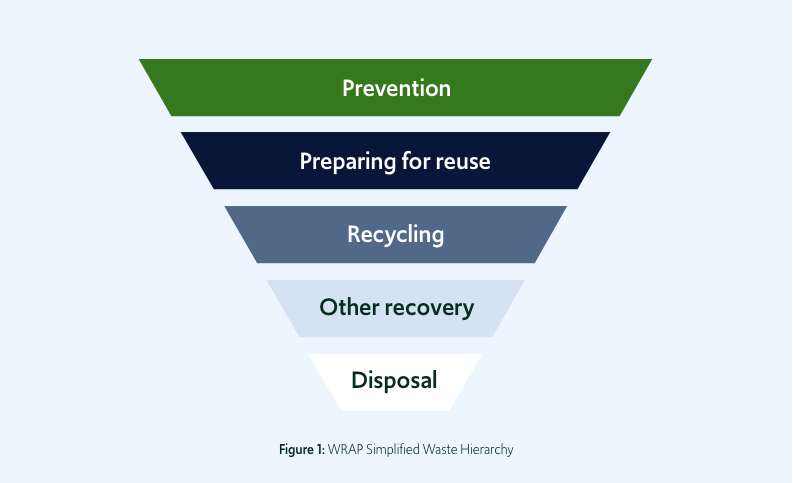
The first method of prevention is perfecting the supply chain forecast, but even with the best will in the world, and if we cannot even get the weather forecast right, what hope is there for predicting the sales of burgers and strawberries in the Summer?
After this, the next method of prevention to explore should be expiration date-based discounting, where expiring products are discounted to encourage customers to buy them and avoid disposal. This process is often referred to as “markdown” and it can be a simple and effective way for retailers to reduce surplus food waste, maintain product margin and increase the sales of expiring items. It is a well-adopted method of tackling surplus food, but one that can cannibalize full-price item sales, as well as impact the perception of product freshness that customers have. It is an approach that is typically implemented through two core types; static and dynamic.
To learn more about this approach, Retail Insight conducted an exclusive research project centered around global retailing markdown processes2. We visited 658 stores across Europe and North America, covering 124 retailers, identifying, and then capturing any evidence of a markdown. All in all, over 9,000 individual data points were collected to analyze and interpret.
From this research, we found that 12% of retailers were not implementing markdowns in their estate at all, meaning they are wasting thousands of tonnes of food that could otherwise have been consumed by shoppers. On top of this, we found that 9/10 retailers have a markdown policy that uses static discounting; regionally, only 5% of Europe and 10% of North America leverage this emerging dynamic discounting technology. The result of retailers opting to use traditional, static discounting methods is that they miss out on optimizing their surplus food waste challenge.
This research is designed to help retailers explore what markdowns are, the different approaches available and why they can be effective in reducing surplus food waste.
Why food waste is high on the agenda

Some 1.3 billion tonnes of surplus food go to waste each year, this equates to one-third of all food produced being wasted3. The financial cost of these figures is estimated at roughly $680 billion; this equates to almost 40% of the total US grocery market4. In addition, food waste is a major contributor to climate change, accounting for 8% of total global greenhouse gas emissions5.
Retailers are the most high-profile link in the food supply chain. Thanks to this reputation, there is a responsibility bestowed upon them that they must lead the fight and improve their practices to reduce overall wastage, as well as influence their customer base to do the same.
As the global visibility of the surplus food problem has grown, new regulations around corporate ESG progress have been introduced. As part of this, most retailers must now rigorously track their efforts to reduce their food waste right across the supply chain, with many being duty-bound to regularly report to their shareholders on this progress. This has resulted in shoppers increasingly aligning their values and ethics to where they choose to shop and the brands they choose to buy.
The forecasting headache
Food supply chain forecasting is a perpetual challenge. Putting it in a climate context, even the world’s leading meteorological centers go from 90% accuracy on a five-day forecast to just 50% on a ten-day forecast. Thus, how can retailers be expected to forecast the fact that you will purchase a 4x pack of beefburgers from Supermarket X in day 10 days’ time, let alone what the weather will be?
This is the reality that retailers face daily, the balancing act of executing an accurate forecast – too little stock and you risk customer dissatisfaction, too much stock and you risk high levels of surplus food; both very costly to the top and bottom-line, thanks to the resulting lost-sales and disposal efforts. As a result, supply chain forecasting has developed into a blend of art and science, with an array of factors feeding into complex models to determine accurate levels of stock required on the shop floor. Yet, even after building advanced models on these factors, and others, retailers can still find it difficult to execute correctly.
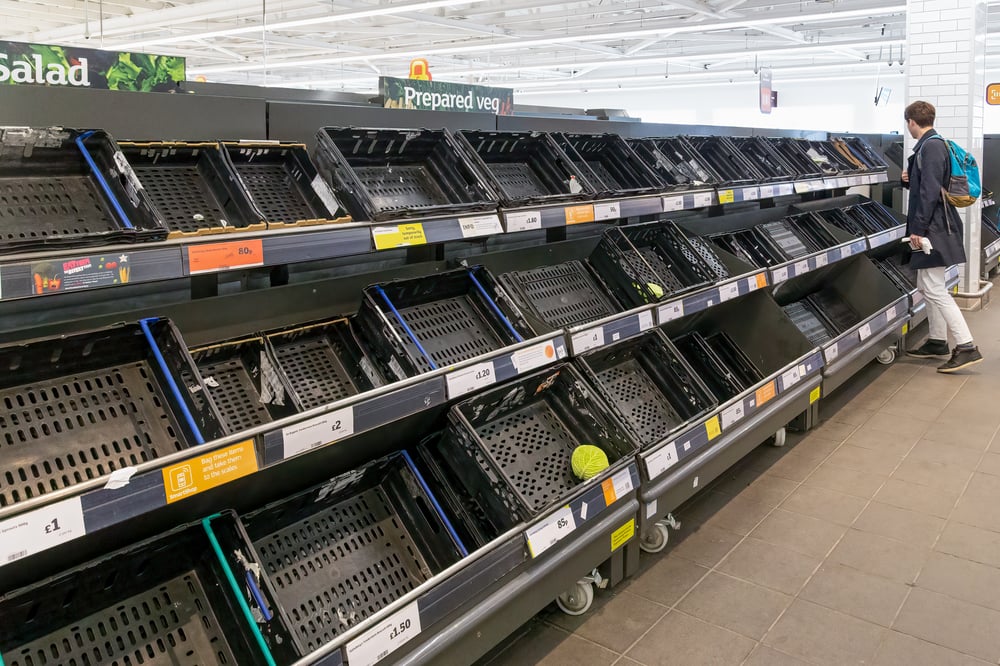
Shoppers in some regions expect to see shelves packed with produce and find empty shelves unsettling. There is an education mission to be done here, as Hannah McCollum, founder of ChicP Hummus, Dips and Veggie Bites, told Retail Gazette6: “Consumers need to have an understanding (and this can come from the retailers), that a shelf which is packed full of produce is not always sustainable – if the shelves are being stacked just to make it appealing, this is another cause for food waste.”
The many variables at play make forecasting complex and inventory management a headache. Retailers need solutions that minimize margin erosion and are not accompanied by large time and labor costs.
“The store manager may not want to spend all their time going back to the shelves to markdown. A balance must be struck between how much time, effort, and hours are invested to get the maximum profit and make sure nothing gets thrown away. The root of the problem is that stores or central buying teams order
too much.”Colin Peacock
Group Strategy Coordinator, ECR Retail Loss Group.
Detailed findings on markdown variance and practice
Before reviewing the core findings of the research, it is worth explaining how the two types of expiry-based discounting models that are available, static and dynamic, work.
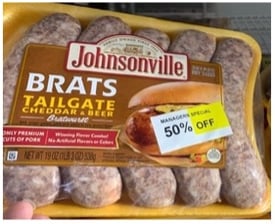
The traditional approach to discounting surplus food is through static markdowns; these can take place through different channels, from clearance areas to manager specials. They are a store-led and manual reduction model, causing poor central visibility and transparency, subsequently leading to low compliance (e.g., fraud and shrink). The static nature of the approach means the discounted prices are not optimized for volume or profit maximization, resulting in retailers often missing out on uncaptured product margins.

This basic model of discounting allows for easy implementation in-store, typically being executed with written or stickered labels, with discounts graduated by velocity across a day or multiple days – a product could be discounted 3 times in the day or in the days leading up to expiry, by 35%, 50%, and 75%. A challenge of the static approach is the fact that discounts are not applied consistently across products or stores, this means there is no visibility to compliance from the center.
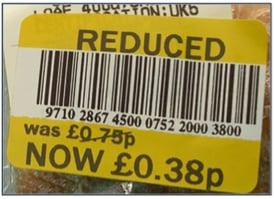
A dynamic model of markdowns is a machine learning-driven approach to surplus food discounting that is designed to produce a price that optimizes the chance of product sell-through and maximizes the product margin captured to find the product’s pricing ‘sweet spot’. The pricing is based on a range of variables and can be adjusted in real-time from store to store, as well as allowing for clear visibility of markdown compliance.
The emerging dynamic discounting approach leverages advanced models to encourage fresh-food velocity, but it requires the supporting technology for it to be executed appropriately. The discounts are printed through barcode labels produced by an in-store associate’s handheld device and printer.
Who is not discounting?
The research showed that 12% of the retailers visited were not using any markdowns at all. As it is virtually impossible to always sell all perishable stock at full price, the inference can be made that stock was going straight to disposal, was donated, or repurposed once it reached its expiry date.
Stores that avoid discounting may take a hit on margin but place a higher priority on protecting brand perception as outlets that only stock the freshest, high-quality produce. Another reason a retailer may not be doing discounting is that they feel that the investment in management, time, and labor is too high to carry out markdowns.
The regional spread of retailers who were not discounting when visited included:
- Europe - 3 retailers out of 75
- North America - 10 retailers out of 49
The reality is that markdowns, when carefully managed can avoid undermining perceptions of excellence. It can shift expiring products off the shelf and into the shopping basket, meaning there is an immediate realization of the benefit. Whilst also freeing up store labor from disposal and recovery practices of unsold products.
“Selling the item and keeping it in the edible food chain is the priority for retailers and consumers, it’s better eaten than fed to animals, converted to energy or thrown to landfill.”
Colin Peacock
Group Strategy Coordinator, ECR Retail Loss Group.
The practical challenges in applying markdown solutions
When reviewing what type of markdown approach had been applied, we found that only 6% of the total markdowns were dynamic – this was a determination based upon the percentage velocity, i.e., 50% vs. 43.23%. This means most retailers are failing to optimise value and the sell-through opportunity of smart discounting.
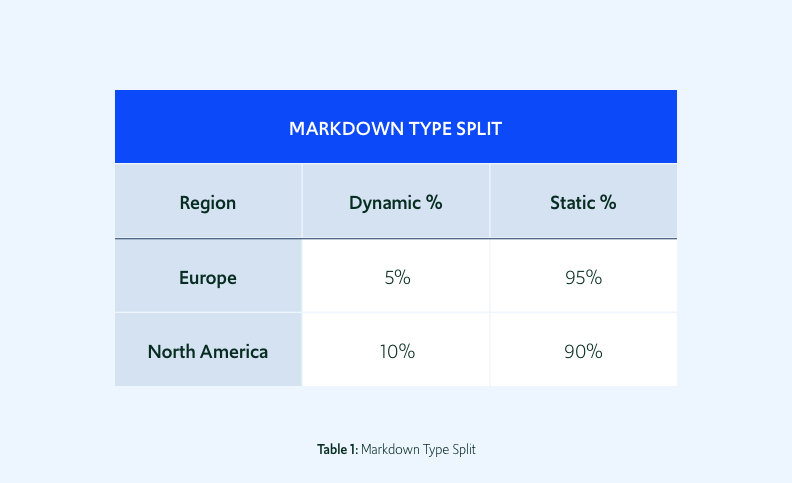
From a regional perspective (Table 1), we found that just 10% of the identified markdowns in North America were deemed to be the emerging, dynamic technology. Conversely, Europe had a lower proportion of incidence of dynamic discounts with a 5% share, heavily favoring the static approach. This was especially prevalent in the DACH countries, including Germany and Switzerland.
This research also enables us to review the sophistication of how the markdowns were applied by the retailer. Europe had the highest number of printed markdowns, heavily driven by the Nordic region. This shows the region is further along the curve in using technology for central office functions and equipping store associates with handheld devices and printers. Whilst North America has a greater balance between stickered and written, with discounts likely being more store-driven and ad-hoc.
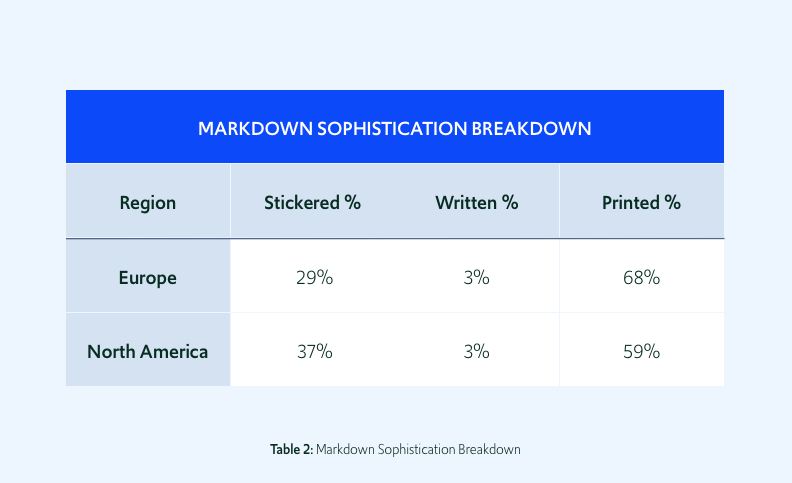
The more basic approach to markdowns encourages large discount giveaways; unstructured ‘trips to the shelf’ to apply the markdown, and human error. If static discounts are being used then the head or regional office has no visibility as to whether the requested discount is being applied not. To add to this, the risk for deliberate fraud to benefit friends, family, or personal business contacts is also likely to be greater.
Who is using dynamic markdown?
The regional spread of retailers who were found to be using a dynamic markdown system included:
- Europe - 5 retailers out of 75
- North America - 10 retailers out of 49
The benefits of a dynamic markdown strategy
A dynamic markdown strategy is a streamlined, data-driven markdown process that recommends the right discount at the right time to encourage sell-through. It means that more of the items that need to be discounted in the store get a discount in a phased and graduated approach. The ultimate aim is to produce a discount percentage that specifically targets an item to sell out before the end of the expiry day, typically achieved by some innovative machine learning-driven algorithms.
Retail Insight’s own WasteInsight dynamic markdown optimization product helped avoid 41,821 tonnes of food waste ending up in landfills across 20207 through the use of cognitive technology – this shows just how significant an impact this approach can have when it comes to reducing the amount of surplus food a retailer will end up wasting.

A centrally managed system of discounting helps support the retail proposition in that every story is discounting if they must, because of surplus food. This promotes stronger compliance across the estate. With a static approach, associates have multiple different touchpoints to apply the markdown. Whilst a more consistent way of working with a dynamic model minimizes the amount of time that in-store associates need to devote to markdowns, due to the headless nature of the modern technology – meaning easy integration with store devices and printers and directive action provided through the system.
One of the big challenges of a traditional markdown model is the lack of effectiveness it provides in maintaining product margins. For example, 10 rump steaks may be discounted at 50% in one store, whilst 1 rump steak is discounted at 90% in another – this erodes the already razor-thin margins on food. However, by optimizing the maximum price a consumer would pay for the expiring product, retailer margins will be far better protected.
Conclusion
There are many approaches to markdowns and retailers must identify the one that works for them based on their budget, processes, and culture. The overarching goal should be to fine-tune a markdown strategy that unlocks the many benefits at hand but most especially drives a reduction in surplus food.
With 12% of retailers not leveraging expiry-based discounting on their products at all, and 9/10 of those who do are not leveraging dynamic markdown technology, there is a huge opportunity for retailers to drastically reduce the amount of surplus food they waste every year.
This opportunity is abundantly clear when you consider that food waste contributes 8% of the world’s total greenhouse gas emissions5, with the total bill of wasted food $680 billion3. The simple truth is that retailers should be doing everything they can to reduce the amount of surplus food they have – both from an environmental and profit perspective.
The retail landscape is shifting, and players must adopt the mindset of the new generation of e-commerce specialists and fight for every incremental inch of margin. New approaches to markdown that empower store managers and associates to do their job more effectively will help in this mission.
As the retail landscape continues to alter, fresh food is becoming the key battleground in which retailers will be able to differentiate themselves from their competition. As a result, the pressure on the perishable food supply chain will only rise, meaning the need for an effective and comprehensive markdown strategy is rapidly growing.

References
- https://wrap.org.uk/
- Methodology: This research involved Retail Insight visiting 658 stores in two regions, collecting over 9,000 data points. The regions were North America (USA and Canada) and Europe (UK, Benelux, DACH, Nordics) and the data points for the exercise were defined as a photo of the markdown item, as well as the old and new price across 5 different store categories; produce, dairy and eggs, deli, meat, and bakery.
- https://www.unep.org/thinkeatsave/get-informed/worldwide-food-waste
- https://www.igd.com/
- https://www.fao.org/publications/card/en/c/7fed720c-18e6-4be4-83d2-385b05b79ace/
- https://www.retailgazette.co.uk/blog/2021/05/retailers-food-waste-covid19-karma-toogoodtogo/
- Internal Retail Insight research
Get in touch
Written by Tom Coe
Tom is the VP of Strategy at Retail Insight. A former NCAA distance runner, he now uses his competitive passion in everything he does at Retail Insight, with a particular focus on innovation and partnerships. He is an MBA graduate from Tulane University and is a Business Management graduate from the University of Birmingham.
It’s time to unleash your retail potential
You might be interested in


Rethinking AI in Retail Operations

Product Availability: A make-or-break battleground

Retail Insight welcomes new CTO – Fredrik Palm

Retail Insight welcomes new CPO, Alex Considine Tong

Latency in Data Kills On-Shelf Availability

Why FSMA 204 presents an opportunity for retailers

AI-Readiness Starts with Accurate Inventory Data

Retail Markdown Optimization: Split Packs & Damaged Items

How Dynamic Markdown Pricing Can Reduce Waste and Boost Profits

How Poor Markdown Pricing is Costing Millions

